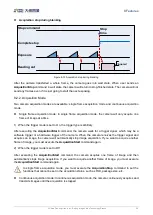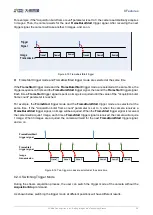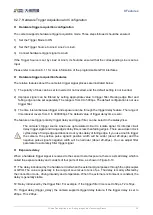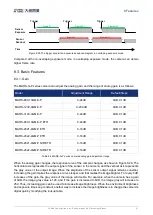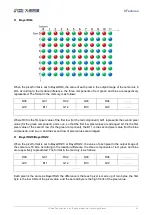
8.Features
© China Daheng Group, Inc. Beijing Image Vision Technology Branch 61
Time
Frame N
Frame N+1
Frame N+2
Frame N
Frame N+1
Sensor
Exposure
Sensor
Readout
Trigger
Trigger
Trigger
Figure 8-25 The trigger acquisition exposure sequence diagram in overlaping exposure mode
Compared with non-overlaping exposure mode, in overlaping exposure mode, the camera can obtain
higher frame rate.
8.3. Basic Features
8.3.1. Gain
The MARS-G-P series camera can adjust the analog gain, and the range of analog gain is as follows:
Model
Adjustment Range
Default/Steps
MARS-880-13GM/C-P
0-24dB
0dB, 0.1dB
MARS-1230-9GM/C-P
0-23.9dB
0dB, 0.1dB
MARS-3140-3GM/C-P
0-24dB
0dB, 0.1dB
MARS-880-13GM/C-P ETR
0-24dB
0dB, 0.1dB
MARS-2621-4GM-P ETR
0-16dB
0dB, 0.1dB
MARS-2622-4GM-P ETR
0-16dB
0dB, 0.1dB
MARS-2621-4GM-P NIR ETR
0-16dB
0dB, 0.1dB
MARS-2622-4GM-P NIR ETR
0-16dB
0dB, 0.1dB
Table 8-4 MARS-G-P series camera analog gain adjustment range
When the analog gain changes, the response curve of the camera changes, as shown in Figure 8-26. The
horizontal axis represents the output signal of the sensor in the camera, and the vertical axis represents
the gray value of the output image. When the amplitude of the sensor output signal remains constant,
increasing the gain makes the response curve steeper, and that makes the image brighter. For every 6dB
increases of the gain, the gray value of the image will double. For example, when the camera has a gain
of 0dB, the image gray value is 126, and if the gain is increased to 6dB, the image gray will increase to
252. Thus, increasing gain can be used to increase image brightness. When the environment brightness
and exposure time keep constant, another way to increase the image brightness is to change the camera's
digital gain by modifying the lookup table.




